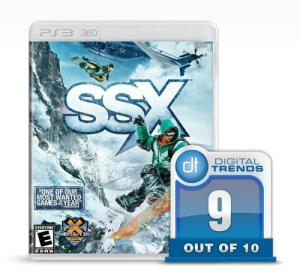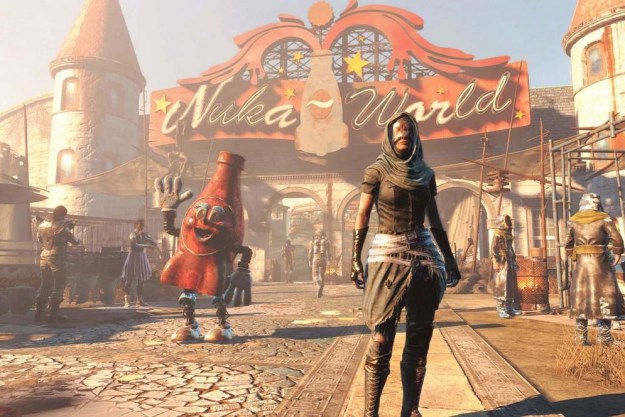
They say that the mark of a good sports game is merely to create an entertaining game that anyone can enjoy. I disagree. Of course, since the “they” in this instance is a fictitious creation of my own imagination used for narrative purposes, that makes this entire argument somewhat schizophrenic. By I digress.
No, to me the true mark of a good sports game is not just the look of it, the features it offers, or even the gameplay—it is the obsessive drive to continuously repeat the same action over and over solely to crush your friends, and thus give you bragging rights. SSX not only offers this, it encourages it.
Naturally the game wouldn’t be worth the effort if it weren’t fun to begin with, but what really sets SSX apart—and not just from other similar games, but most competitive games in general—is the online side of things.

There are a few new bells and whistles, but the core mechanics remain mostly unchanged, which is a good thing. What makes this game stand out is everything else.
The story. Yes, there is a story
Now, you might not expect a snowboarding game built around gravity-defying tricks to be really heavy on the plot, and SSX isn’t. There is a loosely connected narrative that explains the reason for the campaign, the decision to board the deadliest mountains in the world, and it gives an explanation for why you unlock characters and locales.
Basically a former SSX team member named Griff decided to shred the nine gnarliest mountains in the world, and team SSX wants to do it first. That’s about it.
Really, what more do you need? As you begin each new area, you will have a handful of challenges that you need to accomplish before you can tackle the deadly descent of that region. One of these challenges includes a race against a potential new recruit, which unlocks them as a playable character. Once you have that character you are treated to a brief comic book-style glimpse at their lives and personalities. For the rest of that section you then race with that character through the main descent, but as soon as you have completed the race against them, you can use that character in any non-campaign related mode.

Block rocking beats on the world’s highest heights
The music of the SSX series has always been one of the most prominent features of the series, and this iteration doesn’t fail to disappoint. With techno, electronica, and some hip-hop tracks, the selection is big, but you will either like it or hate it based on your own tastes. Thankfully, the game includes the option to import your own music and listen to it while on a run, and there was never a better game to have this feature on. It is a minor, and yet significant inclusion.
But more important than the sound is the level design, which goes above and beyond. SSX features nine of the world’s most infamous mountains, from the aptly named Mt. Slaughter in Antarctica to the world’s behemoth Mt. Everest in the Himalayas. Each area has three real life mountains (with two exceptions: the Himalayas which has four, and one in Japan, which is a PS3 exclusive), and most of the mountains have multiple runs to choose from.
I said it before, and I’ll say it again: that’s just plain cool.These are all real locations, but more than just taking the name and slapping them on a generic level, the basis for each course is taken from satellite imaging of each mountain.

There is something to be said for the first time you unlock a real life mountain like Fitz Roy in Patagonia. Most of us will never see that forbidding chunk of rock in our lives. To play it in a game gives you an odd sense of wonder. Many of these landscapes are forbidding and even alien, and SSX tries to capture that. Sure, the illusion is dispelled the first time you do five back flips in a row, but it really does give the levels some character. They aren’t just bland runs on Mt. Holycrap, there is a sense of connection to these intricately recreated—and then reimagined—levels.
Flipfantasia
As mentioned above, if you have played the SSX games in the past, then you already have a sense of what to expect. There are some changes though. There are several types of runs, from standard timed races, to score based course, as well as a few others like survival, where you need to make it to the bottom with killing yourself—which can be much harder than it sounds. It is still fantastical, but the wackiness of the older SSX is gone.
Regardless of which type of race you are on, you will be able to easily pull off tricks. Beginning a trick is as easy as pushing the right analog stick, but there are modifiers. And modifiers within modifiers within modifiers. It is a system that is easy to use, but could take a long, long time to master. You can also revert to the classic controls if you prefer.
And tricks are a necessity as they build up your boost bar to give you added speed. If you link enough tricks together you can also unleash the “Tricky” mode, which offers signature tricks and extra speed.

As you might expect, you can also purchase additional outfits, boards, and more. If you choose, you can drop down real cash to purchase credits and buy all the equipment you could ever want, plus you can use those credits online (more on that in a moment), which will probably have some people up in arms. SSX isn’t the first, and certainly won’t be the last game to try this. Thankfully you don’t need to buy anything, and you can earn up credits quickly enough just by racing.
The gameplay is fluid and responsive, but these courses can be tough. Very, very tough. In fact, each event in the campaign gives you three tries to win before offering you mercy and allowing you to skip the event and still receive credit as if you had won. Only the twitchiest of gamers will immediately be able to score really well, while most of us will be forced to memorize the courses, but really, that is probably how it should be.

The next level of competition
The campaign of SSX is solid. It is fun, and the courses are well mapped and presented nicely, but it is still a fairly standard campaign—see race, beat race. The multiplayer on the other hand, may cause people to lose their jobs after they become addicted to it and stay home for days to play it.
There are two forms of online racing here: explore mode and global events. The explore mode lets you scan the globe for a type of course you want, then you can compete for medals, or to beat your friends’ score. It is straightforward enough. The global events are a bit different. They are limited events that last a few days, and you compete for credits. The better you do, the better bracket you land in, and therefore the better reward. These events change constantly, and offer a ton of variety.
There are also courses on both the explore and global events that require you to purchase your way in. Some cost a lot of credits, others are mere formalities. When there is a huge pot on the line, this can spice things up, but unless you play the game fanatically and earn more credits than you know what to do, you will need to purchase credits with real life money. This means that these races will either remain untouched for a while until people are silly with credits, or it is a fairly gauche way to bilk you of money. There are plenty of events that aren’t prohibitively priced though, so this really is a minor issue.

This is a slightly brilliant way to approach online competition. In theory you can race online and never, ever feel alone, and you are always competing against the scores of friends and various players, so there is always a reason to race. Plus, you will never have to wait for others to ready up.
The downside is that you can’t go head-to-head with your friends in the traditional sense. But really, the only thing you are losing from that is the ability to push each other into trees or try to ruin their run. While that is always satisfying, the ability to play against your friend’s scores more than makes up for it. You can be competing directly against them even when they aren’t online. It may sound like a simple leaderboard, but it is far more intricate.
Any time one of your friends posts a new score, you can instantly compete against it. A feature called the Ridernet is there to keep all your friends’ scores together, and to show you what they have been up to. If they have entered an event, you can enter. If they posted a new high score, you can try to beat it. And more than just seeing their score, you can actually follow their ghost image through the run. So if your buddy sets a new record, you can see how they did it. It also helps you feel connected, even when they aren’t there.

What there is of the multiplayer is great. Lag is never really an issue since you are racing ghost data and not actual connections, and you can constantly find new ways to compete. A bit more social connectivity and adding things like groups or clubs you could join and compete with would have been nice, but I’m nitpicking. It’s my job.
Conclusion
SSX is not just the best sports game of the year, it is a great game in any genre—as long as you have the patience to improve at it. There will, of course, be those that pick it up and immediately dominate the course. I wish them well (even though I kind of hate them). For the rest of us, it will come down to repetition and learning the courses. That isn’t a bad thing though, and it will increase the replay value of the game, but it may scare off a lot of potential players.
But if anything can encourage you to come back again and again for more, it is the chance to crush your friends’ hopes and dreams online. The multiplayer of SSX is incredible, and you can play it from now until the servers shut off, and still find something new to push yourself at. If you have the time and patience, and you are even remotely interested in the SSX series or snowboarding games in general, then this game will keep you playing for a long, long time.
Score: 9 out of 10
(This game was reviewed on the Xbox 360 on a copy provided by EA)
Editors' Recommendations
- All Baobab Tree locations in Tales of Kenzera
- The most common PSVR 2 problems and how to fix them
- GTA 5 cheats: codes and phone numbers PS4, PS5, Xbox, and PC
- How many skins are in Fortnite?
- The best iPhone emulators


